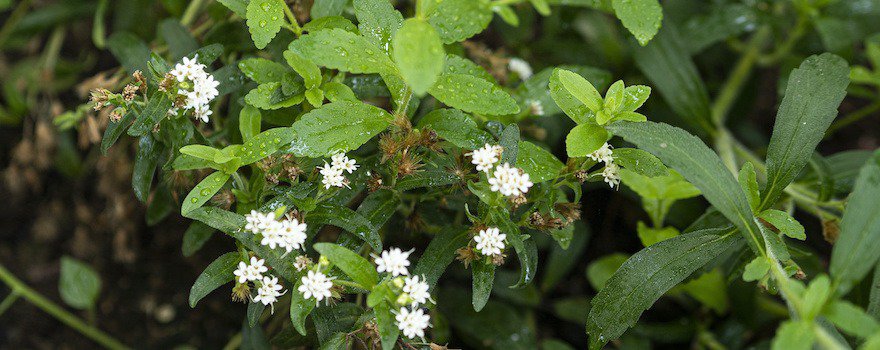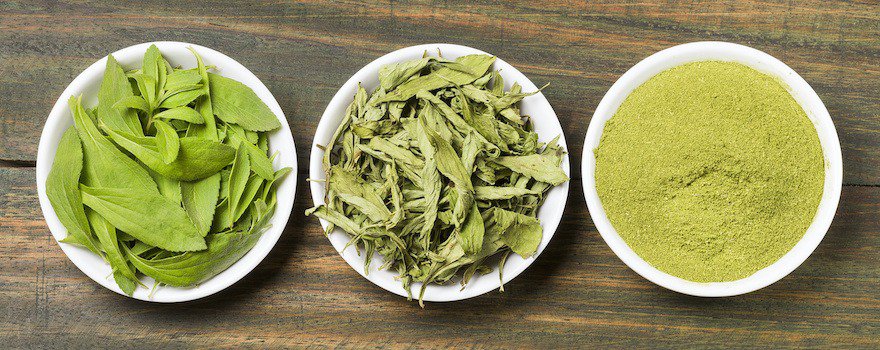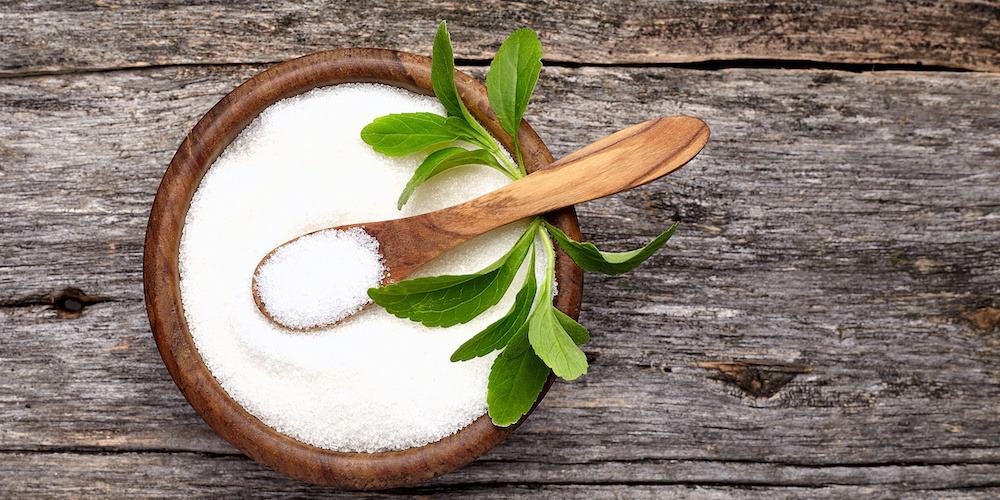BENEFITS OF STEVIA
✓ Reduces blood pressure
✓ Improves diabetes
✓ Fights bacteria
✓ Anti-inflammatory
✓ May help maintain weight
What is stevia?
Stevia, scientifically known as Stevia rebaudiana, is a plant belonging to the Asteraceae family, like chicory or yarrow. Native to South America, it naturally grows in high-altitude regions, between 500 and 1500 m. It is most commonly found in Paraguay, Bolivia, Argentina, and Brazil, where it enjoys a humid yet sunny climate.
Like agave, stevia has been appreciated and used for centuries for its sweetening power, which is much higher than that of sucrose (white sugar).
This quality is due to the steviol glycosides or steviosides, natural sweeteners found in its leaves. Thus, in pre-Columbian times, stevia was already used by the Guarani Indians to sweeten and soften their bitter drinks like yerba maté.
It was not until the 16th century that it became the subject of research highlighting its sweetening properties. Gradually, it established itself worldwide as a natural alternative to white sugar. But its leaves also stand out for their exceptional composition. Indeed, they contain vitamins, amino acids, minerals, trace elements, and fatty acids.
Numerous studies show that stevia helps reduce blood pressure, improves diabetes, and fights certain pathogenic bacteria. It is also anti-inflammatory and aids in weight loss.
This plant was banned in the United States for a long time. And for a good reason: it directly competed with aspartame, a sweetener used by most major international firms. However, some of them eventually began using it, replacing aspartame and saccharin. This is notably the case for Coca-Cola or Danone, seeking to offer a range of reduced-sugar products.
Nutritional Composition
- Amino Acids
- Vitamins: A, B1, B3, C
- Minerals and Trace Elements: iron, calcium, zinc, magnesium, potassium, sodium
- Lipids
- Proteins
- Fibers
- Carbohydrates
- Glycosides: steviosides, rebaudioside, rubusoside, dulcoside A, steviolbioside
- Fatty Acids: palmitic, palmitoleic, stearic, oleic, linoleic, linolenic acid

The benefits of stevia
🌡 Reduces blood pressure
The consumption of stevia contributes beneficially to the regulation of blood pressure. The plant has hypotensive effects by promoting vasodilation and inhibiting the activity of angiotensin-II. This enzyme decreases the caliber of blood vessels, thus leading to an increase in blood pressure.
This action is believed to be due to the steviosides present in the plant’s leaves. These sweet compounds reduce both systolic (maximum) and diastolic (minimum) blood pressure in hypertensive individuals.
This study conducted by the National University of Asuncion (Paraguay) on men demonstrates how steviosides affect blood pressure.
🍭 Improves diabetes
Stevia has various beneficial effects on diabetes. On the one hand, it does not cause blood sugar spikes after meals. Indeed, the carbohydrates resulting from its consumption are utilized by the microbiota and thus do not enter the bloodstream.
On the other hand, the steviosides it contains lower blood sugar levels and stimulate insulin release. Like konjac, it also has the advantage of having a very low glycemic index, as it is 0.
This study from the Maharshi Dayanand Saraswati University (India), conducted on diabetic patients, shows how stevia improves diabetes.
🦠 Fights bacteria
Stevia has antibacterial properties and fights against certain pathogenic bacteria. Its glycosides slow down their growth and proliferation. Additionally, they inhibit their hemolytic power, meaning their ability to destroy red blood cells.
It has proven particularly effective against the bacteria Escherichia coli, Salmonella typhimurium, and Staphylococcus aureus. It also fights cariogenic bacteria, responsible for dental cavities. Finally, it seems to counter the development of the bacterium Borrelia burgdorferi, responsible for Lyme disease.
This study from the University of Latvia, conducted directly in the lab, demonstrates the antibacterial action of stevia glycosides.
🔥 Anti-inflammatory
Stevia has anti-inflammatory effects and notably reduces damage to the lungs and liver. It’s also beneficial in cases of arthritis, osteoarthritis, osteoporosis, and chronic rheumatism.
On one hand, its steviosides inhibit the NF-KB factor, a protein involved in the inflammatory response. On the other hand, they reduce the tumor necrosis factor alpha (TNF-α) and the levels of pro-inflammatory interleukins 1 and 6.
This study from Harbin Medical University (China), conducted on mice, shows the anti-inflammatory action of stevia.
🏃🏻♂️ Might help maintain weight
Stevia is a valuable ally for weight management within a diet. It doesn’t cause weight loss but helps maintain weight and control weight. Indeed, it is a good substitute for refined white sugar without adding calories. Its caloric intake is simply 0!
Additionally, it has up to 300 times the sweetness of table sugar. It thus allows for reducing sucrose consumption, a quick sugar involved in overweight and obesity.
However, more studies are still needed to confirm stevia’s effect on weight loss.

How to consume stevia?
Stevia powder
Stevia is most often offered in powder form. Once harvested, the leaves are dried and then ground. They then undergo an extraction process to retain only the steviol glycosides, which are purified shortly after.
The powder is a practical and easy form to use in cooking to “sweeten” all kinds of preparations: cookies, cakes and pastries, beverages… It also has the advantage of being resistant to baking up to 200°C. It has the same texture as sugar but is distinguished by an anise-like aftertaste, similar to licorice.
Dried stevia leaves
Dried stevia leaves are a minimally processed format. They allow for the preparation of teas and infusions with a licorice flavor. The resulting infusion can also be used to sweeten other beverages as well as sauces, soups, desserts…

Sustainable consumption: prioritize local, organic, and fair-trade stevia
✓ China is the world’s largest producer of stevia, providing 80% of the production or about 6000 tons per year. This cultivation has also spread to North Africa, Australia, the United States, and even Europe. In France, some farmers decide to try the adventure like here in the southwest, a region suitable for stevia cultivation.
✓ If possible, choose a stevia cultivated in France using organic farming and purified with water, without chemical substances. Indeed, during maceration and filtration processes, methanol or ethanol can be used by industries. Moreover, in industrial products (soda, etc.), it is not the whole plant that is used but a molecule of the plant.
✓ Fair-trade channels are also interesting to support the work of small stevia producers, in Brazil, for example.
Dosage
The recommended dosage is 1 g of stevia per day.
Contraindications and side effects
The consumption of stevia presents certain contraindications :
- As a precaution, it is not recommended for pregnant and breastfeeding women and young children;
- People suffering from diabetes, hypertension, or hypotension should consult their doctor before consuming it;
- Its consumption may interact with certain medications for hypertension or hypoglycemia.
The consumption of stevia has very few side effects. Only an allergic reaction may occur in people sensitive to plants of the Asteraceae family.
If you experience side effects, stop consuming it and consult a doctor.
Report by Julia Perez
Source and scientific studies
Antonello Santini, Lydia Ferrara, Daniele Naviglio, A. Aragón, Alberto Ritieni, 2008. Stevia: Non caloric natural sweetener.
Luis A Barriocanal, Mafalda Palacios, Gilda Benitez, Sussam Benitez, Jorge T Jimenez, Nora Jimenez, Vicenta Rojas, 2008. Apparent lack of pharmacological effect of steviol glycosides used as sweeteners in humans. A pilot study of repeated exposures in some normotensive and hypotensive individuals and in Type 1 and Type 2 diabetics.
Mathur Rit, Johri Nandini, 2016. Nutritional composition of Stevia rebaudiana, a sweet herb, and its hypoglycemic and hypolipidemic effect on patients with non-insulin dependent diabetes mellitus.
I Deniņa, P Semjonovs, A Fomina, R Treimane, R Linde, 2014. The influence of stevia glycosides on the growth of Lactobacillus reuteri strains.
S K Goyal, Samsher, R K Goyal, 2010. Stevia (Stevia rebaudiana) a bio-sweetener: a review.



